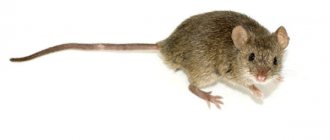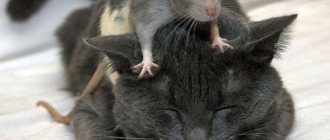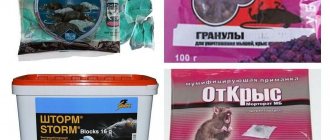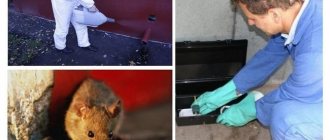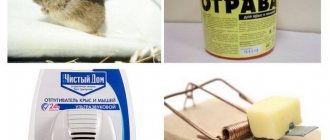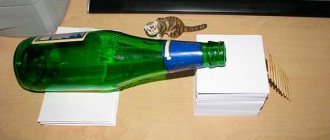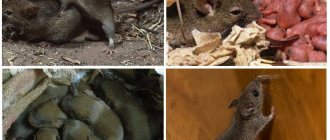There are more than 30 species of mice. The most common are the house mouse and the vole. Rodents cause a lot of harm: they spoil food in homes, pantries, and basements, they contaminate apartments, outbuildings and food products with feces, and they spread diseases. In the garden, voles damage plants, eat roots, tree bark, flower bulbs, fruits and vegetables. In buildings, rodents damage insulation and bite cables. Therefore, the fight against them must begin immediately. We will tell you how to get rid of mice in the house, at the dacha, on the site using folk remedies and using various methods.
Description of pests
Controlling rodents is usually quite difficult, but necessary, because under favorable conditions animals reproduce easily and quickly. Let's find out how these mice differ, what are their characteristics and habits in order to effectively deal with them.
House mouse
The animal Mus musculus or house mouse, which can be found in your home, garage, basement, is characterized by strong synanthropy. Synanthropic organisms are animals, plants, and microorganisms associated with humans. So, this rodent is found wherever people live. Its presence has even been confirmed at research stations in Antarctica.
House mice have many natural enemies that occupy higher positions in the food chain. Many predators feed on rodents - cats, wild dogs, weasels, foxes, birds, snakes. Therefore, in the wild, mice usually live 5-6 months. In the laboratory or as a pet they can live up to 2 years.
A female house mouse reaches reproductive capacity in 2 months. Then every 3-4 weeks the mouse is able to give birth to a dozen children. More than 100 cubs can be born in a year! Therefore, if you notice a rodent in the house, there will soon be many more of them.
Mice are nocturnal animals and go out in search of food after dark. They are omnivores, love to eat fruits, plant grains, meat, and dairy products. They even eat their own excrement, obtaining nutrients produced by bacteria living in their intestines.
They have poor eyesight, but good hearing and smell. Mice use their whiskers to sense temperature changes and surface textures. Rodents live in complex burrows with long entrances and multiple escape routes; they keep the burrows clean - they have separate places for storing food, sleeping, and toileting.
To get rid of mice, you should familiarize yourself with information about their characteristic behavior. Then you will be able to take adequate actions to prevent the rodent from entering your house or warehouse.
Features of behavior:
- House mice are very curious creatures. Every day they explore new territories in search of food sources. It is worth taking care to block any possible ways for rodents to enter the house. It is necessary to seal the holes with silicone or cement mortar. Additional protection is to store food in the pantry or basement in carefully closed containers.
- The animal is looking for warm places. The assault on houses or warehouses occurs from October to February, when rodents are looking for premises where they can shelter from the cold, get food and water. When the temperature drops by several degrees, they take refuge in basements, sheds, houses; rodents may also appear in a city apartment.
- Every year it is necessary to properly prepare for the upcoming cold weather by conducting a thorough inspection in the fall of the premises most susceptible to unwanted visits from rodents.
- Greed. The mouse eats 15-20 times a day. She makes a burrow close to food sources (up to 8 m away) for easy access. At night, the animal moves between different feeding points, taking only 0.15 g of food from each point. To track an animal, you need to check in which places there are traces of food (for example, a specific smell), then look for holes nearby.
- Loves to take a bite and throw it away. A mouse's teeth grow throughout its life. To wear down the teeth to a manageable size, the animal must continually bite and chew on objects. Victims of biting become electrical wires, which can cause a fire. Therefore, it is important to ensure that electrical systems are properly protected. If you suspect the presence of rodents near electrical equipment, you need to start scaring them away as soon as possible. Electromagnetic repellers help with this.
Identifying a potential rodent infestation is much easier than trying to find an actual mouse. Look for the following signs:
- Scratching sounds: These can be heard at night when mice are most active. Listen for sounds between partitions, under floorboards, in false ceilings, basements, and attics.
- Droppings: Mice leave small, dark droppings, especially along walls or in high-traffic areas such as countertops, cabinets, shelves, and under the sink.
- A peculiar odor: mice leave behind a trail of ammonia odor, which is felt especially strongly in confined spaces (closets).
- Mice need to chew on wood, plastic, cables, and other hard materials to keep incisor growth under control. Gnawing can even cause a house fire if mice chew on electrical cables.
- Nests. Rodents build nests from newspapers and fabrics. The nests are usually hidden, for example behind a refrigerator.
- Traces of sebum (spots, streaks) arise due to the fact that mouse fur constantly rubs against walls, floors, and baseboards on popular routes. You may notice dark stripes around holes and corners.
- Paw and tail prints can appear in dusty places, such as unused attics and basements.
- Rodents usually live in basements and attics; it is worth carefully inspecting these rooms to determine whether there are mice or other pests.
Mice can spread up to 200 different pathogens and parasites. They contaminate the surface and food with excrement, excreting it 40-100 times per day. It’s unlikely that anyone would want to find a hole in their favorite sweater, carpet or wiring. Therefore, it is worth taking quick and effective action to combat rodents.
Red vole
Small rodents, bank voles (lat. Myodes glareolus) from the family Hamsters (lat. Cricetidae) cause enormous damage. The vole lives in meadows, wastelands, gardens, and greenhouses. She has a stocky body, a short head, and a blunt muzzle. The vole lives 2-4 months, often in colonies. The female gives birth 6-7 times, 5-10 cubs per litter. Males and females care for their own and other people's offspring, so the death of the parents does not entail the death of the cubs. The vole feeds within a radius of 10-15 m around the burrow. She does not fall into winter sleep; in winter she continues to dig tunnels in the ground, sometimes moving into wooden outbuildings. This is the most common and dangerous pest among rodents.
Voles can damage:
- rhizomatous plants (carrots, parsley);
- vegetables; fruits, flower bulbs;
- plant roots;
- bark of trees, especially young ones.
How does a vole differ from a house mouse?
- fur color - the vole has reddish-brown fur, hence its name - bank vole, house mice are gray-brown;
- the vole is smaller in size - 15 cm long (including the tail and body itself: 10 cm), weighing 20 g;
- more often found in the ground, not in the basement, house;
- has characteristic black large eyes and sharp teeth, thanks to which it gnaws through twigs, roots, and bark;
- distinctive feature is a two-color tail;
- shorter tail and paws than the house mouse.
Voles come out in the evening and at night. They will not damage basements and only feed in the garden. Some people confuse the damage caused by voles with the destruction caused by moles. Unlike moles, voles do not create mounds. This is the easiest way to determine who has settled in the garden - voles or moles. Voles dig tunnels with a diameter of 5 cm. The entrances to the burrows are located nearby. They gnaw plants from below, causing them to quickly wither.
Prevention of invasion
How to deal with pests in a country house, private house or utility room? For prevention you should:
- eliminate all cracks and cracks on the floor and walls, cover the ventilation with special grilles;
- install screens on windows;
- reliably protect food products in sealed containers made of plastic, glass or metal;
- Maintain cleanliness in all areas.
When performing all this work, you should be very careful, since even a small gap in the wall, on the floor or at the junction of the screens and windows is enough for the animals to get inside your home. An important point is maintaining cleanliness in the premises. These animals have an excellent sense of smell, so if there is edible food in accessible places, it will be immediately destroyed by representatives of the mouse family.
In order to quickly eliminate rodents from your home, you can use mint. They cannot stand the aroma of this plant, so all places that smell of mint are unsuitable for them to live. You can use not only the leaves, but also peppermint oil. At the same time, you need to change the grass quite often. This is due to the fact that as soon as the premises stop smelling of mint, animals will immediately get inside. This method is effective not only for preventing an invasion, but will also help if you are tormented by pests.
How to protect your home from mice
- Food . Store food in closed containers. It is important not to attract rodents with products. If possible, store food in plastic or metal containers, especially flour and cereals. It is important to hide leftover food so that it does not lie on the tables.
- Regular house cleaning . Clean under the stove, refrigerator, and cabinets regularly.
- Doors . Attach bristle tape or brush under the door to prevent penetration.
- Pipelines . Seal the holes around the pipes with stainless steel wool and caulk.
- Holes. Often people make holes in external walls for laying pipelines and wiring. Any openings larger than 5mm will allow mice to gain access to the house as their jaws fit into such confined spaces and will quickly chew through large openings that allow entry into the building.
- the ventilation holes with a thin galvanized mesh, especially if they are damaged.
- Ceilings, roofing . Repair damaged roofing and use chicken wire to close any gaps. You should carefully monitor whether there are small cracks near the roof through which pests can enter.
- Vegetation . Trim tree branches so that they do not touch the walls of the house. To keep mice out, trim vines or overhanging branches that mice can use to climb onto the roof. Lush vegetation near walls will provide mice with cover and a potential nesting site.
- Lawns. Keep your lawn mowed to prevent mice from hiding in the grass when they sneak into your home. Ideally, leave a cemented space between the house's foundation and the garden.
- Maintaining order in the area will help get rid of rats and mice. Careful disposal of food waste, tightly sealing and emptying trash containers tightly, regularly cleaning up after pets, and storing flower bulbs, vegetables and fruits in rodent-proof containers will deprive animals of food sources and force them to seek out better habitats.
It is important to systematically check the tightness of the house. It is worth starting with a thorough check of the condition of the walls in the attic, in the basement, and sealing (for example, with a dense fine-grained metal mesh or special steel wool against rodents) all openings through which pests can enter the house.
To get rid of mice in the walls of a country house, summer residents seal the holes made by pests with broken glass and mortar, then carefully plaster the wall.
Mice easily chew through polystyrene foam and mineral wool, so during the construction or insulation of a house, every few meters it is necessary to line the walls with wire mesh to protect against various types of rodents.
Drywall walls are an excellent refuge for mice. When building houses prone to rodent infestations, it is very important to reinforce plasterboard walls with metal mesh at a distance of 30 cm from the floor. Some builders recommend laying broken glass or a layer of glass wool or ecowool in the walls. You can pour a layer of boric acid inside.
Do some general cleaning
The last warm days of autumn are a busy time for summer residents. Harvesting, preparing trees for winter, cleaning and digging up the site takes a lot of time, sometimes there is no time left to clean the house and remove property. In vain! It is imperative to do a thorough cleaning of the premises so as not to give the mice a reason to “feast.”
We do the following:
- we empty the cabinets of food debris and packets of seeds;
- we clean garbage containers;
- we remove and take away fabric curtains, towels, bedding;
- We remove paper, newspapers, magazines, plastic bags;
- We take away country clothes, shoes, gloves;
- throw away plant debris;
- We close the water containers - mice can climb into them and introduce pathogens;
- We wipe down the furniture and wash the floors with vinegar and wormwood oil.
The emptier and cleaner your house is, the less rodents it will attract.
Effective methods and methods of dealing with mice
Among the available methods, we can distinguish more traditional ones, including folk methods and modern ones, characterized by less or more invasiveness.
Mousetraps
Traditional traps have a spring mechanism that hits the mouse in the neck and kills it. But there are mousetraps that allow you to humanely get rid of the problem of rodents that lure the animal and then close. The rodent ends up in a trap and can be released into a field or forest. The most commonly used are traditional mousetraps.
You can use the following as bait for mice:
- cheese;
- bread sprinkled with vegetable oil;
- a more picky mouse will be tempted by sausage;
- smoked meats have a strong, alluring smell;
- a real gourmet will be attracted by chocolate.
Bait traps are installed near burrows and rodent feeding areas; be sure to check them every 1-2 days.
Glue traps
An interesting tool is a glue trap for mice - this is glue paper to which the mouse sticks when it is attracted to a treat. The rat trap uses a special glue that prevents rodents from coming off the surface. The glue does not contain poisons or toxins. Slots on the cardboard allow the glue trap to be folded up to be placed in hard-to-reach areas.
Photo. Different types of sticky baits for mice and rats
DIY plastic bottle trap
A good solution is to make a trap out of a plastic bottle. Once a mouse is caught, it can be easily released away from home. A plastic bottle is used as a base, which needs to be cut, then equipped with a mechanism made of sticks, rubber bands, thread and a paper clip. Proper assembly creates a trap door that the mouse will fall into after it enters the bottle. A few tidbits should be placed as bait. When a mouse enters and bites the cheese or other treat, the open bottle closes. As a result, the rodent will be trapped.
Use of natural and folk remedies
Below we present ecological methods on how to get rid of mice in the country using folk remedies at home:
- You can put bags or soap with lavender in wardrobes, closets, and chests of drawers to effectively scare away mice and rats from your home. Place dried mint, oleander, or tansy in areas frequented by rodents. Tansy grows in meadows and wastelands and has a characteristic, strong odor. Lining the attic or basement with dry tansy grass repels mice.
- You can pour oils with mint and lavender scents onto pieces of cotton wool and spread them around the apartment.
- Mice don't like the smell of vinegar.
- Mice do not tolerate the smell of hairspray or moldy lemon. These are great ways to get rid of mice in the cellar, basement, or attic - just spray varnish or put a moldy lemon under the nest.
- You can place sheets of aluminum foil near the minks, which mice are afraid of.
Repellers
A harmless device is a mouse repeller that uses ultrasonic waves, which are unpleasant for rodents and inaudible for humans. Repellers emit ultrasound of various frequencies, divided into bands corresponding to individual operating modes, as well as electromagnetic signals.
Ultrasound at appropriate frequencies is unbearable for animals with very sensitive hearing, such as mice, for long periods of time. It's like living with a roommate who always listens to music very loudly. The unfriendly ultrasonic environment created by the repeller forces mice to leave the home where the device is used. Repellers are connected to the network or powered by a battery.
The best mouse repellers have sophisticated automated systems for changing the ultrasonic signal. Due to this, animals cannot get used to the operation of the device. The effectiveness of deterrence depends largely on the individual. Frequently leaving unprotected food and lack of order provide shelter for rodents and access to food. Before using the repeller, you need to make sure that hidden places and food debris are eliminated.
Chemicals
The most effective way is to use poison. In the basements of apartment buildings, mouse and rat poison are used as a standard remedy. The preparations are available in the form of granules, cubes, and soaking liquids. Their smell attracts rodents. The composition of some poisons (“rat death”, “mortorate”) protects the bodies of rodents from decomposition and has a mummifying effect, which is of practical importance, especially important in rarely visited enclosed spaces.
You need to be careful about the poison and place it in places where children or pets will not come into contact with it. In open places, it is better to pour such preparations into special feeders - containers that will prevent access to poisons for people and pets, and protect them from exposure to rain and moisture.
An effective poison for mice is based on the action of anticoagulant substances. The active ingredients most commonly used in rodenticides include difenacoum, bromadiolone, and brodifacoum.
The most effective blue poison for mice is made from brodifacoum.
Before using poison, there are several important points to consider:
- each drug must be used in accordance with the manufacturer's recommendations;
- chemicals that are poisonous to mice and rats are dangerous to people and animals, so it is better to avoid them if children are playing in the garden or pets are running around;
- Chemicals, especially dusty preparations, can be spread by rodents throughout the area on their paws and fur, so it is better not to use them in pantries, basements, greenhouses with vegetables, and food storage rooms.
The last step, when nothing else has helped and there are too many rodents, is deratization. This is an expensive method that requires paying a team of specialists, but it will allow you to get rid of rats and mice in a private home, if not forever, then for a long time.
When deratization, it is necessary to leave the house for a day, since the vapors of the chemicals used are harmful to humans.
Traps
Traps, bottles, containers with a flimsy bottom, glue traps - all this gives little effect and allows the gardener to get rid of 1-3 mice that accidentally entered the house. More often, young animals end up there, and pregnant females are cautious, so it is completely impossible to eradicate mice in the country using traps.
Important! The danger with glue traps is that they trap pets instead of rodents. Kittens and puppies die, an adult can only be removed with a piece of skin and meat, so such traps are installed in an empty house for the winter.
How to deal with voles?
Before deciding how to get rid of field mice in the garden, keep in mind that rodents perform an important function in nature, so it is better to drive them out, take them to the forest, without destroying them. If humane methods fail, take radical action.
Rodents love certain conditions - they live well in gardens, greenhouses, where there is fertile, humus soil, or where tunnels have been dug out by moles. To effectively get rid of voles in a summer cottage, several methods are used at once. Exposure to one remedy will not usually give the desired results. Below are proven ways to control voles.
Do not use a thick layer of mulch
Mulching the soil prevents weeds from growing quickly, retains moisture in the soil and is extremely beneficial for plants. However, you should not use a thick layer of mulch; voles love it.
Make it difficult to access plants
Voles love to eat bulbous plants and the soft bark of fruit trees. To protect the trunks of young trees from rodents, it is enough to use special plastic garden fences or cover the trunks with straw.
For bulbous plants, it is enough to use special baskets in which the bulbs are buried in the ground, preventing the access of mice. Baskets for planting bulbs should be made of durable materials, such as galvanized steel wire.
Voles will not get through to the roots and bulbs that have protection. You can lay out a PVC mesh or wire between the crops - this will make it difficult for rodents to access.
Destroy dug corridors
Rodents build a network of tunnels underground, so it's worth looking for entrances to them. If corridors are discovered, they should be filled with water or plugged. If this doesn't help, you can dig up the ground.
Natural enemies are predators
The first line of defense against rodents is their natural enemies:
- birds (owl, kestrel, buzzards or buzzards);
- martens;
- hedgehogs;
- domestic cats;
- dogs.
It is worth creating conditions that encourage rodent predators to visit the garden. Voles are extremely shy, so getting a dog or cat is helpful to drive them away from your property. It is worth getting a cat whose night hunting coincides with the life of rodents. Rodents are afraid of cats; when they notice our four-legged friends, they will avoid the garden.
It is worth inviting hedgehogs to live in the garden. They need a quiet place with uncut grass and a small house covered with branches and leaves.
Birds of prey are enemies of voles; it is worth encouraging them to fly to our garden. To do this, you can hang feeders and create observation posts for birds; they will quickly drive out the rodents.
Repellent plants
Voles do not like the following plants:
- marigold,
- garlic,
- mint,
- black currant,
- spurge,
- sweet clover,
- mustard,
- castor bean,
- fresh tomato leaves,
- wild chamomile,
- tansy flower.
Just plant them in your garden early.
At the entrance to the burrows you can place plants whose smell rodents cannot tolerate:
- garlic;
- thuja branches;
- elderberry branches;
- walnut leaves;
- moldy lemon;
- crushed shoots of thyme, juniper;
- mustard greens;
- bowls with dried herbs (mint, chamomile, thyme, lavender, mustard).
Using the right plant will keep rodents out of the garden quickly. You can use ready-made repellents (granular) impregnated with appropriate aromas.
Sound repellents
Sound deterrence is an effective way to get rid of mice, rats, and voles. It is enough to build a simple structure yourself to fix the problem. A bottle placed on a rod buried at an angle will do. A gust of wind entering the interior causes a sound that deters rodents.
An equally effective invention is an aluminum can placed on a metal wire. A tin can moved by the wind will make a lot of noise, scaring away pests.
It is worth paying attention to the store offers - acoustic repellents that feed on the energy of sunlight. The sounds they make are inaudible to people, but they repel mice, voles, and moles, affecting their nervous system. Acoustic repellers are not harmful to pets.
Smoke candles
A good way to control voles is with smoke candles. All you have to do is light a candle and insert it into the vole tunnel. The smoke from the candle settles in the corridors dug by rodents, scaring them away. In order for the product to perform its repellent function, it is important to find the tunnels in which the voles are currently feeding. The substances released from the candle can be harmful, so this method must be used with caution.
Traps
Traps allow you to quickly catch voles without causing harm. Special mechanisms effectively solve the problem of rodents. They are equipped with hatches that close as soon as the voles try to get out. The devices can be easily placed in underground corridors.
Natural preparations
Natural preparations based on organic composition will repel voles, including:
- Castor oil;
- lavender oil;
- garlic extract.
Voles cannot tolerate these substances, but they are not harmful; they only drive rodents out of the garden.
Chemical substances
When all methods of controlling voles fail, garden owners turn to chemicals. Manufacturers offer quite a few different drugs. Their composition is toxic and can harm other animals, it is important to be careful. Individual drugs are injected into the vole tunnels.
Chemicals
There are different drugs, they all differ in their principle of action. It is not recommended to use products containing substances hazardous to humans (lead, arsenic, strychnine, thallium) in household conditions. It is better to use drugs whose effect is aimed only at rodents. Products containing anticoagulants are popular today. These substances negatively affect the circulatory system. They block blood clotting, which provokes multiple hemorrhages in the body of rodents.
These substances include coumarins and indanediones. An example of a drug based on anticoagulants is Zookoumarin. There are products that differ in their operating principles. For example, the drug Krysid provokes respiratory arrest in mice. It is recommended to choose poisons that promote mummification of the dead pest. Then, after the death of the rodent, an unpleasant odor will not appear.
There are poisoned baits. They are offered in the form of liquids, powders, pastes. Thanks to the attractants included in the composition, rodents will be eager to try the poison. This makes the room treatment procedure easier. Now you don’t need to lay out toxic substances everywhere, just place the bait in several places and the mice will come to it themselves.
The first results can be observed within a day. Different drugs work at different rates. The poison is left in places where rodents frequently appear. A small amount (10-20 g) is enough. The bait is periodically updated. This should be done with a break of 8-10 days. There are baits that operate on a different principle. For example, Clean House Storm. This product resembles grains in appearance and contains pathogenic microbes that provoke the development of murine typhus in rodents. If one individual becomes infected, others will soon become ill. The drug is safe for humans.
How to remove an unpleasant odor?
Often, after rodents visit your home, an unpleasant odor remains. It smells especially strong and unpleasant in the summer, in the heat. Therefore, it is important to know how to get rid of the smell of mice in the house.
The most important thing is to remove all traces of rodent activity. They are often difficult to detect. It is necessary to sort through all the supplies, wash the storage containers, remove the kitchen drawers, move the refrigerator, wash the pantries, remove and check the baseboards. You can wash white surfaces while wearing gloves. You also need to clean the attic and basement.
If a mouse has died under the floor or in the wall, tearing down the floors or destroying the walls is a radical measure. You can wait, if the mouse is small, it will dry out quickly.
When traditional methods have failed, you can clear the space with the involvement of professional companies. Ozone is used in areas where decomposing dead pests have been found.
Mice create big problems for owners of houses, gardens, and vegetable gardens. They spoil food supplies, leave feces, stain and chew things, gnaw tunnels in walls, and cause an unpleasant odor, especially in summer. The reasons for the appearance of rodents are obvious: animals are looking for food and shelter. Fortunately, there are many ways to contain them in an effective and humane manner. And it’s better to do everything to prevent them from appearing - keep the house and garden clean and tidy, use all kinds of repellents.
Harm to humans
This rodent is quite large in size compared to other types of mice, and therefore quite dangerous for agriculture. They spoil the harvest both in the field, which has not yet been harvested, and in granaries, as well as in other warehouses where food is stored. When they want to eat, and they always want to eat, they eat grains, tomatoes, sunflowers, cabbage, carrots, beets, etc.
When they get into the cellar, they can destroy all the reserves, most of which the rodent simply spoils and humans cannot eat such products. With the onset of spring, the pest moves to the area where it begins to eat young shoots of cultivated plants, which causes serious damage to the crop that has not yet appeared. Therefore, if a vole mouse appears on the site, it is necessary to immediately take measures to destroy or expel it. It must be remembered that this rodent reproduces quite quickly.
Ways to protect fruit trees
In winter, the wood of fruit trees is a real treat not only for mice, but also for hares and other rodents. The first thing you need to do if at least one side of your plot overlooks a forest or field is to fence off your own territory with a high, solid fence, installing it on a concrete base or digging it into the ground at least 30 cm.
Fruit tree wood is a treat for mice in winter
The following methods will help protect trees from mice in winter:
- When preparing a tree for winter, the trunk is wrapped in several layers of covering material, burlap, and nylon tights. Place branches of any coniferous tree between them, placing their needles down. The best option is spruce; its needles are short, prickly, and stick out in different directions. Cover the tree trunk circle with spruce branches. The needles prick the sensitive noses of rodents; they do not touch the tree. The spruce branches do not interfere with the aeration process.
The spruce branches protect fruit trees not only from rodents, but also from frost - Wrap the trunk with roofing felt so that it is not completely adjacent to the tree. In winter, it will protect the tree not only from rodents, but also from sunburn. But the roofing material practically does not allow air to pass through, so the cover must be removed in time, avoiding the root collar becoming warm. Mice often make digs, so the roofing material needs to be dug into the ground at least 15–20 cm.
In the spring, roofing material from the fruit tree must be removed before a constant positive temperature is established. - Fence trees with fine mesh plastic or metal mesh. It also needs to be dug into the ground. Metal is simply too much for mice, and they really don’t like the specific taste of plastic.
The net must be dug into the ground, otherwise it is useless for protection against mice - In preparation for winter, whitewash the trunk and the lower third of the skeletal branches. The composition based on slaked lime is quite caustic, mice do not like it. To enhance the effect, manufacturers add special substances that repel rodents to store-bought whitewash; to homemade whitewash, they add shavings of tar soap and zinc oxide (zinc compounds are the basis of many poisons for rodents).
Autumn whitewashing performs many useful functions; this stage of preparing a fruit tree for winter cannot be neglected - If you have old buckets and large pots without a bottom, put them on young seedlings, digging them 15–20 cm into the ground. Such a barrier is impenetrable for mice, but they sometimes climb over it from above.
Don't rush to throw away an old bucket without a bottom - it can be put to useful use
The tree trunks of fruit trees are often mulched. In general, this is a very useful agrotechnical event. But do not choose straw as mulch - mice often live in it.
